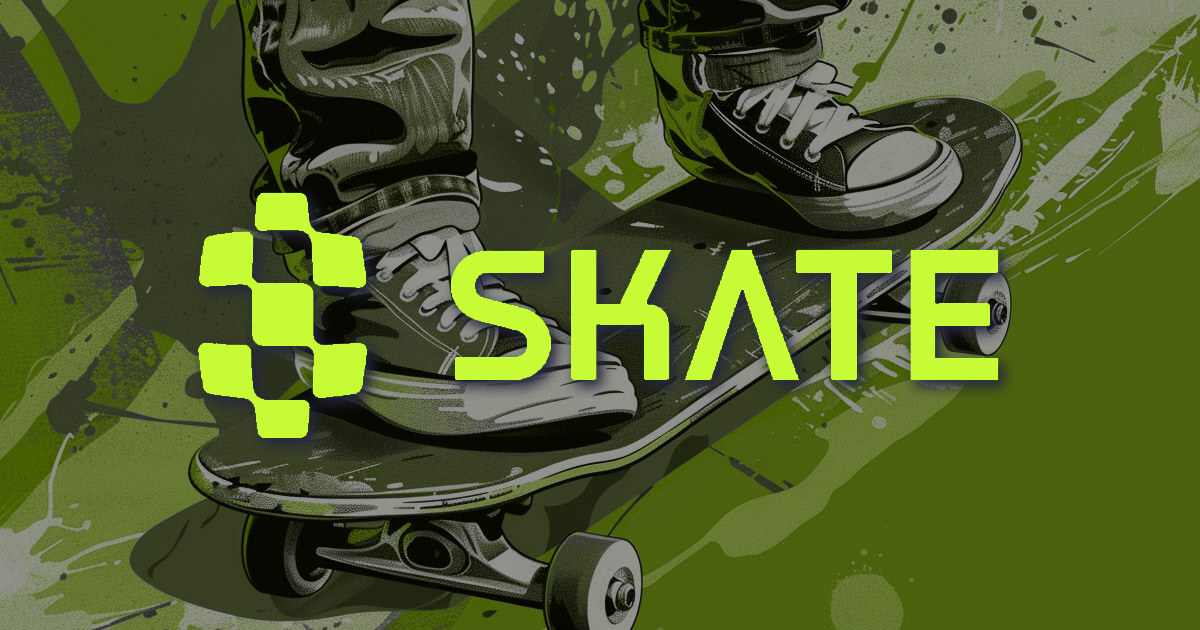
Siddharth Lalwani is on a mission to redefine the blockchain ecosystem with Skate, a common software layer built-in with EigenLayer that allows apps to run seamlessly throughout hundreds of chains with a single, unified state. Because the Co-Founder and CEO of Vary Protocol, the corporate behind Skate, Siddharth brings deep experience in web3 infrastructure and DeFi from his expertise at main corporations like Altonomy, Point72, Bybit, Certik, and Citigroup.
On this unique interview, Siddharth shares his imaginative and prescient for fixing the challenges of software fragmentation and liquidity silos that plague the present multi-chain panorama. He explains how Skate’s progressive strategy of embedding interoperability into the core software logic can streamline improvement, improve consumer experiences, and unlock the true potential of a modular web3 future.
With assist from main gamers like Polygon, Manta, Axelar, and extra, Skate is poised to form the subsequent evolution of blockchain app improvement. Learn on for an illuminating dialogue with one of many main minds on the forefront of this thrilling frontier.
Skate is supported by the likes of Polygon, Manta, and Pendle. Past the apparent vote of confidence, what particular experience and synergies does this group deliver to Vary Protocol and the event of Skate?
Every of those titans brings a wealth of technical data and expertise in blockchain fundamentals, good contract improvement and scalability options. With Polygon and Manta, builders in every scalable ecosystem can profit from Skate as an answer to embed cross-chain interoperability on the software stage from the get-go and eradicate the costly burden of price for liquidity bootstraps. This strategy permits for extra customers to proliferate throughout numerous ecosystems. With Skate’s pre affirmation layer secured as an EigenLayer actively validated companies (AVS), it could actually assist dApps with ample belief minimised assumptions and produce exponential use circumstances within the realm of restaking. Pendle additionally performs a vital position in controlling LRT tokens, that are integral to the governance and operational mechanics of the Eigenlayer, additional strengthening Skate’s infrastructure for decentralised finance purposes.
By way of strategic partnerships with these distinguished web3 tasks, we in fact profit from their community results — getting access to networks, communities and sources — to speed up adoption of Skate and growth of credibility inside the DeFi neighborhood.
Whereas Skate goals to unify software improvement throughout chains, there’s potential for disruption to present ecosystems. How do you stability innovation with the chance of destabilising present programs?
Fairly than searching for to override present programs, prioritising interoperability ensures that Skate can coexist harmoniously inside established ecosystems. The spirit of coopetition (aggressive cooperation), is intrinsically interwoven into the material of blockchain. By facilitating seamless interplay between completely different chains in real-time by intent-centric execution and leveraging EigenLayer for accelerated finality, Skate enhances somewhat than disrupts present infrastructure.
Skate is solely making it simpler for multi-chain deployment. The broader web3 ecosystem is unified in its objective to create an interconnected tapestry of tokenised economies. This doesn’t change the underlying utility of software improvement in numerous digital machine (VM) environments — that in itself requires important sources and instruments like software program improvement kits, working programs and the like. The important thing lies in assuaging the useful resource burden for builders of dApps and blockchains to allow them to give attention to constructing expressivity, as an alternative of focusing efforts on backwards compatibility, to learn all gamers within the web3 worth chain.
What are the potential dangers related to Skate’s implementation throughout various blockchain environments?
When apps combine Skate, they will run on all chains with one single state — permitting them to work together with customers on 1000s of chains. Also referred to as the Common Software Scope, it ensures that the applying logic is maintained as a unified state on Skate, whereas belongings stay on their native chains. This ensures foundational wants of builders and customers are met effectively, permitting every chain to give attention to creating value-added companies and laying the constructing blocks for a modular future.
As with all type of interoperability, there are dangers concerned with regards to cross chain communication. We’re designing the infrastructure such that sure whitelisted gamers tackle interoperability dangers to supply sooner finalities, which considerably reduces assault vectors. Other than that, our imaginative and prescient is to have EVM apps run throughout EVM and non-EVM chains with one world state, like a liquidity pool working on Ethereum and Solana with one state. This will likely introduce new good contract dangers to have a typical intent normal in between them. We will likely be present process a number of audits prior and following our mainnet launch.
Given the eye and success of EigenLayer and its current launch, how does Skate use EigenLayer’s product suite (AVS, DA), particularly within the context of this distinctive multi-chain strategy?
Skate is at present at its testnet section and has two main elements, a customized Optimism Bedrock hub chain and Pull based mostly state oracle working as an AVS. Any software leveraging Skate could have its state and app logic reside on Skate. For customers interacting, they will signal intents throughout any of the supported chains and get the effectivity of the worldwide software state throughout all of the chains. Mainnet is anticipated to be stay by the top of Q2 2024. When Skate’s Common Software Scope ultimately goes stay on EigenLayer mainnet, we count on it to boost performance and effectivity as software executions occur in actual time with sooner finality, enabling completely different integral legos like AMMs, lending markets, NFT marketplaces and such.
With the formidable scope of Skate, may you focus on any sensible challenges or limitations you have encountered when attempting to combine with present blockchain infrastructures? How did these challenges inform your strategy?
Skate faces a number of sensible challenges when integrating with various blockchain infrastructures. Firstly, establishing a typical normal, equivalent to a unified signature protocol between completely different ecosystems like Solana and Ethereum, is essential. This requires aligning numerous technical specs and governance fashions, which could be advanced because of the distinct architectures of every blockchain.
Secondly, attaining sooner finalities whereas managing blockchain reorganisations (reorgs) presents a big problem. Reorgs necessitate a sturdy mechanism to make sure that transactions stay legitimate and constant throughout chains. Skate is actively refining its methods to deal with reorgs successfully, striving to boost the robustness and reliability of cross-chain interactions.
Are you able to present an instance of a state of affairs the place Skate won’t be the perfect resolution? How do you handle expectations across the platform’s capabilities?
A possible state of affairs might be when dApps require deep integration into a particular blockchain that may not be simply adaptable by Skate. If a dApp depends closely on a selected blockchain’s consensus mechanisms or native tokenomics, Skate’s generalised strategy won’t absolutely accommodate the intricacies required by dApps. In such circumstances, it could make extra sense to construct and deploy the dApp immediately somewhat than use Skate as an middleman layer.
Interoperability introduces advanced safety challenges, particularly when working throughout hundreds of chains. What particular safety measures are built-in into Skate to handle these vulnerabilities?
Skate addresses the inherent safety challenges of interoperability by a multi-layered strategy:
- EigenLayer AVS: Skate utilises EigenLayer to boost safety and be certain that purposes function appropriately throughout completely different chains. This layer acts as a pre-confirmation mechanism, offering sooner finalities with excessive financial belief.
- Whitelisted Intermediaries: To mitigate dangers in cross-chain communications, Skate employs whitelisted intermediaries which might be chargeable for managing pre-confirmation interoperability functionalities. These intermediaries are rigorously vetted and required to fulfill excessive safety requirements to minimise potential vulnerabilities.
- In depth Auditing: Steady auditing processes are applied, involving a number of safety audits and code opinions from each inside groups and exterior safety corporations. This helps establish and tackle potential vulnerabilities in Skate’s infrastructure and maintains the integrity of its cross-chain operations.
Have there been any compromises or trade-offs when it comes to safety to realize the excessive stage of interoperability that Skate guarantees?
Whereas striving for prime interoperability, Skate does face inherent trade-offs:
- Velocity vs. Safety: The necessity for quick finalities throughout chains might typically battle with the thoroughness required for optimum safety. To deal with this, Skate utilises whitelisted intermediaries to supply sooner finalities, whereas pulling all stops to take care of strong safety protocols.
- World State Dangers: Sustaining a world state throughout each EVM and non-EVM chains introduces new good contract dangers. Widespread intent requirements between these various environments have to be fastidiously managed to forestall vulnerabilities.
Skate proposes to vary how builders have interaction with blockchain expertise. What are the financial implications for builders, notably these invested within the present multi-chain ecosystem?
Provided that Skate permits builders to work throughout 1000s of chains, this grants builders entry to an infinite web3 consumer pool. They will leverage Skate to faucet into the liquidity and consumer base of a number of chains, enhancing the financial potential of their purposes.
The present multi-chain ecosystem is tormented by fragmentation, with purposes and customers scattered throughout completely different blockchain networks. Skate’s unified strategy to software improvement might help cut back fragmentation by consolidating improvement efforts and fostering a extra cohesive ecosystem, ultimately resulting in stronger economies of scale for builders.
How do you intend to incentivize adoption amongst builders who is perhaps skeptical or comfy with present platforms?
We goal to redefine the blockchain ecosystem by a world scope of purposes. Taking inspiration from groundbreaking strides made by the Optimism Collective, the Skate Stewards initiative lays the inspiration for a community that champions specialisation. By harmonising key purposes and options throughout various blockchain applied sciences, Skate goals to get rid of redundant processes and allow every chain to leverage on one another’s strengths.
Incentive applications equivalent to grants, bounties, developer rewards or token incentives for constructing and deploying purposes on Skate, will likely be launched to these contributing to platform improvement, or selling adoption inside the developer neighborhood. Such applications encourage experimentation and drive engagement amongst builders.
What criticisms or skeptical suggestions have you ever obtained about Skate thus far? How do you reply to those critiques?
One of many nuanced criticisms of Skate considerations the way it can compete with native apps, which frequently profit from preferential incentives and a deeply entrenched neighborhood particular to their respective chains. In response, Skate acknowledges the strengths of native purposes however emphasises the added worth it brings to those ecosystems by interoperability. Skate goals to boost the attain and performance of native apps by connecting them to a broader community of chains and communities. This not solely exposes native purposes to new customers and markets but additionally permits them to take part in a bigger, interconnected token financial system, probably multiplying their development alternatives and incentives.
One other concern is that requiring all executions (on any collaborating chain) to additionally execute on the Skatechain would possibly create a bottleneck, particularly because the variety of interactions scales up. Critics fear that this might restrict scalability and effectivity, centralising an excessive amount of processing and decision-making inside the Skate infrastructure. In addressing this critique, Skate factors to its architectural and technological methods designed to mitigate such dangers. These embrace using superior consensus mechanisms, scaling options like sharding or layer 2 applied sciences, and the opportunity of offloading sure forms of processing to sidechains or specialised nodes inside the community. Skate is constantly evolving its expertise to make sure that it could actually deal with rising masses with out changing into a central level of failure or inefficiency.
Wanting ahead, how will Skate adapt if the preliminary assumptions about market wants or technological feasibility do not maintain true?
The inception of Skate arose from recognising consumer expertise constraints and challenges encountered by crypto-natives searching for to seamlessly transfer and utilise belongings throughout completely different blockchain networks. Presently, 90% of improvement efforts on EVM chains is spent solely on forking apps that work on Ethereum on a brand new EVM chain. That is clearly an inefficient mannequin. If not Skate, some protocol will ultimately remedy that. Because the panorama of modular blockchains throughout hundreds of chains continues to evolve, we’re dedicated to staying adaptable and conscious of shifts in market calls for. Our objective is to repeatedly bridge gaps throughout this various ecosystem, making certain that blockchain expertise stays accessible and user-friendly for an ever-changing atmosphere.



